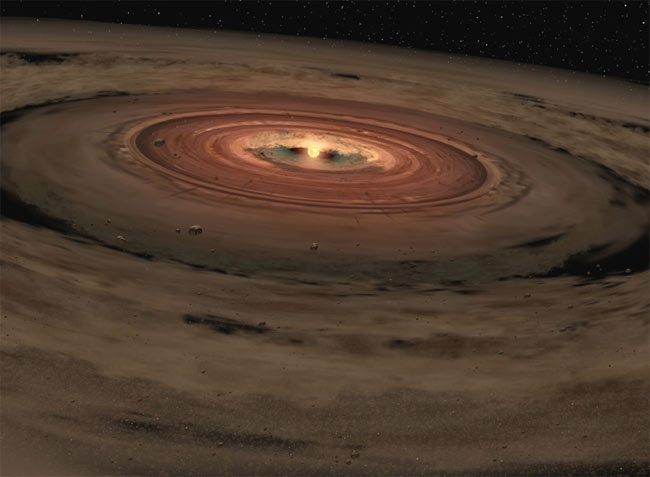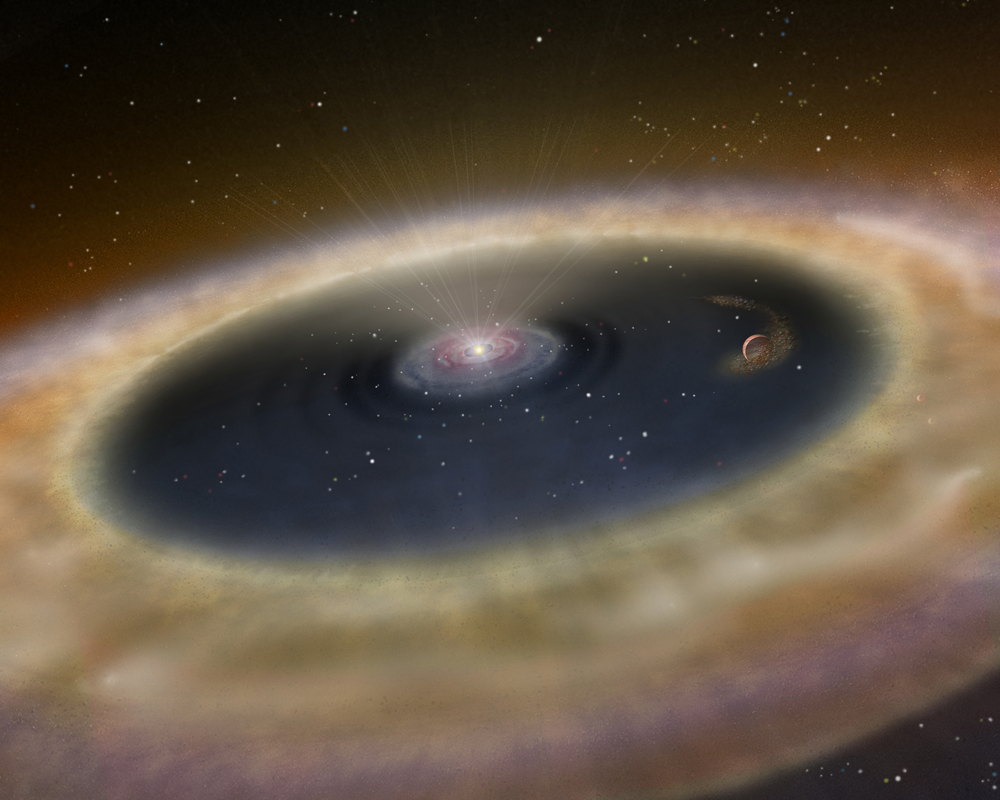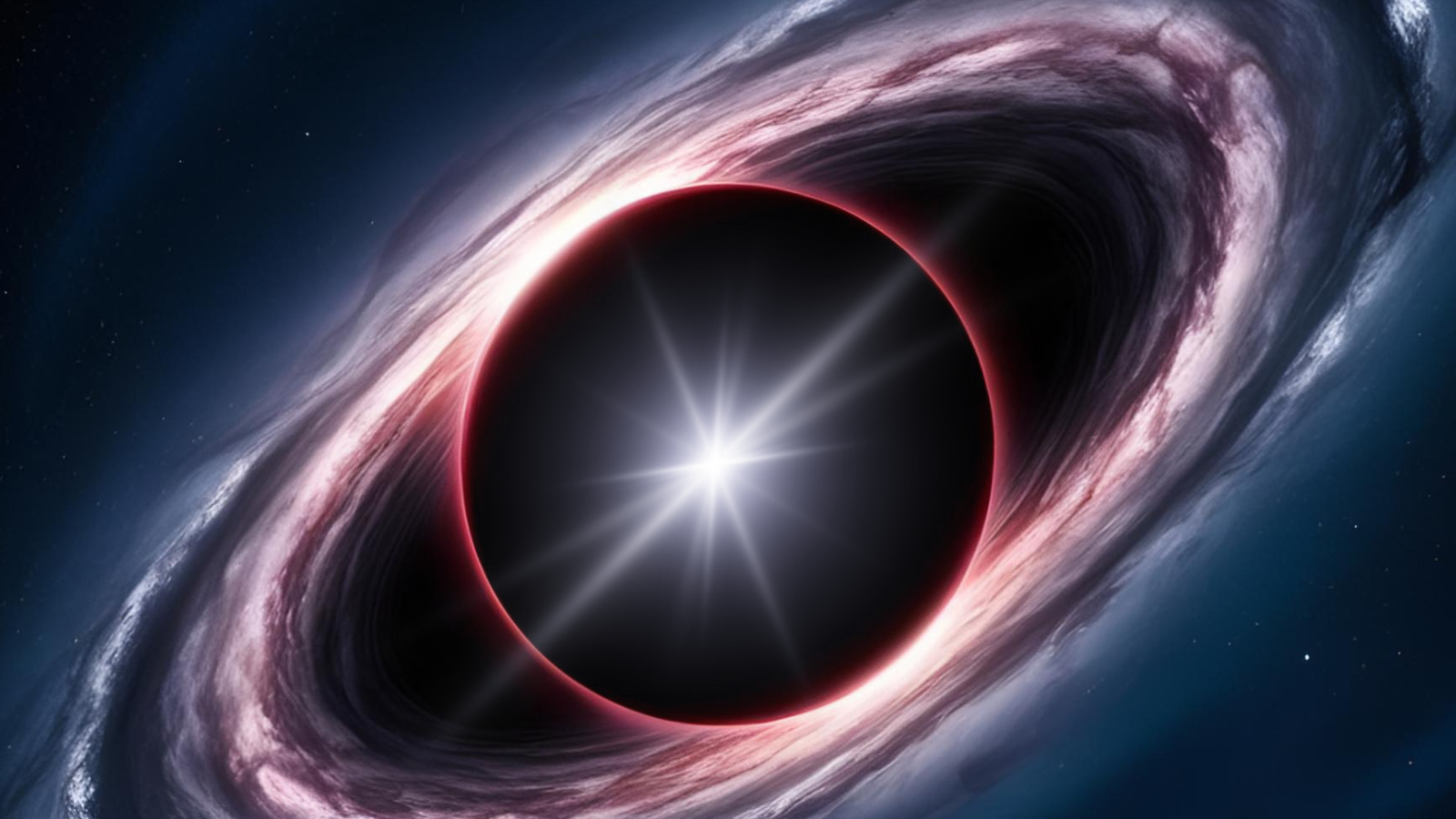Earth-like Alien Planets May Hide in Dust Around Distant Stars

Stars with disks of debris around them might be good targets to search for Earth-like alien planets, researchers say.
Debris disks consist of fields of planetesimals and dust encircling stars. A few hundred stars have been found that show signs of a debris disk, said astrophysicist Sean Raymond of the Observatory of Bordeaux in France.
The lifetime of dust is very short compared with that of stars — for instance, the dust can get scattered out into interstellar space by gravitational perturbations from giant planets. It is thought that any debris disks astronomers spot are replenished by collisions between asteroid-sized bodies that are basically leftovers of rocky planet formation. As such, if any disk that is seen is relatively large, its system might be calm enough in terms of its orbital dynamics for rocky worlds to form.
"For debris disks to exist around old stars, you need a dynamically calm environment without strong gravitational perturbations. To form terrestrial planets, you need the same thing. So, it makes sense that these two outcomes should be correlated," Raymond said. "I think the most important implication of the findings is that, if I am right, then debris disks can act as signposts for systems with a high probability of having terrestrial planets and, in some cases, Earth-like planets."
Modeling planet formation
To explore this idea, Raymond and his colleagues simulated how planets emerge from debris disks. Inner disks apparently form rocky planets in 10 to 100 million years, the result of impacts between asteroid-sized planetesimals and moon- to Mars-sized protoplanets. [The Strangest Alien Planets]
Inner disks are not massive enough to produce the cores of giant planets. These arise farther out in the disk, in the "snow line" far away from the sun where temperatures are low enough for hydrogen compounds to condense into icy grains.
Get the Space.com Newsletter
Breaking space news, the latest updates on rocket launches, skywatching events and more!
It is thought that gas giants usually form within the first few million years after the appearance of a star's protoplanetary disk. This means they could influence rocky planets in the inner debris disk as they are still forming.
To see what effects giant planets might have on rocky planet formation, the research team simulated an inner disk of 500 planetesimals and 50 planetary embryos equal to nine Earth masses at a distance of one-half to four times the distance of Earth to the sun; three gas giants at distances matching that of Jupiter or Saturn at five to 10 times the distance of Earth from the sun; and an outer disk of planetesimals equal to 50 to 100 Earth masses 10 to 20 times the distance of Earth from the sun, comparable to our solar system's Kuiper Belt. They then let these systems evolve for 100 million to 200 million years.
"I ran more than 500 simulations that each took between a few weeks and six months to run," Raymond said.
Depending on the masses, orbits and other properties of the disks and worlds used in the simulations, the gravitational instabilities triggered by the giant planets can eliminate most or all of the planetesimals and rearrange the positions of the planets.
The researchers found that stars with wider and more massive outer disks are more likely to harbor rocky planets, since planetesimals in these outer disks can diminish eccentricities in the orbits of gas giant planets, reducing the chances the gaseous planets will gravitationally sling the rocky planets outward.
Systems with less massive Neptune-sized giant planets are also very likely to support terrestrial planets.
"Raymond and collaborators have identified a path that can guide us toward terrestrial exoplanets at Earth-like distances from their star," said planetary scientist Rory Barnes at the University of Washington, who did not take part in this research. "These planets are extremely challenging to detect, so any clues that narrow down the search is of great value."
"The good thing about this idea is that it's testable simply by searching for low-mass planets around stars with debris disks. That work is in progress," Raymond noted. [Gallery: The Smallest Alien Planets]

Our oddball solar system
Intriguingly, our solar system looks unusual given these findings because it has rocky planets as well as giant planets that are relatively calm in terms of their orbital dynamics, but no debris disk.
"So, why don't we have this dust?" Raymond said. "Well, it turns out that for more than half a billion years after its formation, the solar system did have a bright debris disk! As is the case for other stars, the dust was produced by icy planetesimals occasionally colliding and grinding themselves away. This population of planetesimals was the primordial Kuiper Belt, and we think it contained about 50 Earth masses of material, at least 100 times more mass than it does today."
However, the Kuiper Belt was almost completely cleared out during a period instability about 3.8 billion years ago that is linked with the "Late Heavy Bombardment," when asteroids were slung around the solar system, leaving planets with scars still visible today.
"This instability shifted the orbits of the giant planets — Jupiter and Saturn moved a little bit farther away, but Uranus and Neptune were scattered outward into the primordial Kuiper Belt," Raymond explained. "Uranus and Neptune proceeded to almost completely destroy the Kuiper Belt mainly by scattering objects inward toward Jupiter and Saturn, who proceeded to gravitationally eject them from the solar system, and a very small fraction impacted the Earth and moon and other planets. This explains the almost circular orbits of Jupiter and Saturn and the dearth of dust." [Photos: Saturn's Rings & Moons]
Future research could use the models that Raymond and his colleagues developed to estimate if stars hosting debris disks might host rocky planets. One candidate might be Eta Corvi, whose surrounding dust might be the remains of a collision between an Earth-like world and one or more comets, an alien version of our solar system's Late Heavy Bombardment.
"It would be great if their work can help give us a physical picture of what's going on in Eta Corvi," said astrophysicist Carey Lisse at the Johns Hopkins University Applied Physics Laboratory, who did not participate in this study.
Rare debris disks
Although Raymond proposes that stars with debris disks should be good places to look for terrestrial planets, it turns out only about one in six stars older than 1 billion years are observed to have debris disks.
"What about stars without debris disks?" Raymond asked.
The fact that many stars apparently do not have debris disks "probably means that lots of stars simply aren't born with enough material to make debris disks," Raymond said. "The vast majority — about 100 percent — of very young stars do have circumstellar disks but the outer parts of many of these must either be disrupted, perhaps by passing stars within their stellar nursery, or just not contain enough stuff to make debris disks."
Still, that does not mean these disk-less stars lack terrestrial worlds, as one can see in our own solar system.
"Instead, giant planets can be used as a barometer — stars with giant planets on distant, low-eccentricity orbits are probably good environments for terrestrial planet formation, and stars with close-in or high-eccentricity giant planets are not," Raymond said.
"In conclusion, it's hard to say anything about a specific star with no debris disk, although statistically speaking, it may have terrestrial planets," Raymond said. "But a star with a debris disk, according to me, has a high probability of hosting terrestrial planets, and if it also doesn't have an eccentric giant planet, the probability is even higher."
The scientists are publishing their findings in the journal Astronomy & Astrophysics.
This story was provided to SPACE.com by Astrobiology Magazine. Follow SPACE.com for the latest in space science and exploration news on Twitter @Spacedotcom and on Facebook.
Join our Space Forums to keep talking space on the latest missions, night sky and more! And if you have a news tip, correction or comment, let us know at: community@space.com.

Charles Q. Choi is a contributing writer for Space.com and Live Science. He covers all things human origins and astronomy as well as physics, animals and general science topics. Charles has a Master of Arts degree from the University of Missouri-Columbia, School of Journalism and a Bachelor of Arts degree from the University of South Florida. Charles has visited every continent on Earth, drinking rancid yak butter tea in Lhasa, snorkeling with sea lions in the Galapagos and even climbing an iceberg in Antarctica. Visit him at http://www.sciwriter.us
